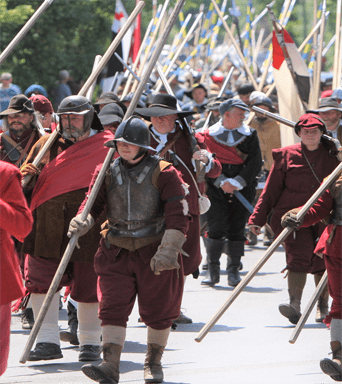Much is known about the soldiers and battles of the 17th Century English Civil Wars, but far less is known about how the lives of ordinary people living in England were affected. When Parliament took away the crown from Charles I, they tried to make amends to the people by asking each town and village to send in a report of what losses they had incurred during the wars. The idea was to compensate those who lost money due to the war. However, there is no record of them actually being paid.
These records have been carefully preserved in the National Archives and in a project covering the Warwickshire Loss Accounts, 20 volunteers, with help from the Dugdale Society and Heritage & Culture Warwickshire, have transcribed records for the whole county.
After nearly 400 years, these accounts reveal just how much the local families suffered. Just like today’s civil wars throughout the world, the impact on the ordinary person was immense, and lasted for many generations. Civilians experienced threat, violence and intimidation from soldiers who collected taxes, and soldiers passing through the district were often hungry and not paid well, so they plundered goods and stole food. Livestock were killed to eat and anything combustible seized to cook them on, grass and crops were trashed by the horses for fodder, and homes were even burnt down if there was resistance.
Transcribed accounts for Southam include a record that the soldiers ‘wounded a towns man that he dyed presently’. A Flecknoe man had money and goods ‘taken by violence’. Stockton had only 42 households, yet they had to provide food and accomodation for 800 horses and men for two days and two nights, when the cavalry horses ate bare their grass and grazed their crops down for fodder.
Wounded soldiers were left in villages to be cared for and either departed to fight again once healed, or as in Bishops Itchington and Southam after the Battle of Edgehill, were buried in the churchyards. In June 1645 Southam and the surrounding villages found themselves hosting soldiers not only on their way to the Battle of Naseby, but a couple of weeks later on their way back, now including many wounded. The plunder in Southam during 1645 by the Scots Army, when St James’ Church was damaged, is very well recorded.
One could say that Southam was in the centre of the wars; because of the town’s central location between Coventry, Banbury, Warwick and Daventry it lay on the line of march of both Royalist and Parliamentary soldiers across Warwickshire.
To look at any Warwickshire Loss Account record, select https://heritage.warwickshire.gov.uk/civilwaraccounts and click on the required place.
The Southam Heritage Collection has a display featuring social life during the Civil Wars in its High Street window as well as an account of the Battle of Southam on sale in Linda Doyle’s book.
Southam Heritage Collection is located in the atrium of Tithe Place opposite the Library entrance. We are open on Tuesday, Thursday, Friday and Saturday mornings from 10am to 12 noon. To find out more about Southam’s history, visit our website www.southamheritage.org.uk, telephone 01926 613503 or email southamheritage@hotmail.com You can also follow us on Facebook.


Leave A Comment